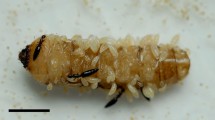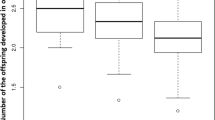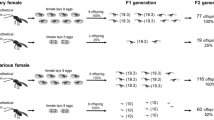Summary
Parasitoid wasps often lay male eggs in small hosts and female eggs in larger hosts. The selective advantage of this strategy can be explained by assuming wasp fitness increases with host size and that this fitness increase is greater in females than in males. I conducted experiments to test a model based on this explanation and found the results generally supported the model with one exception; unlike what the model assumed, these wasps were unable to adjust their offspring sex ratios in each generation to different host size distributions. This finding suggests an alternate view as to how selection might operate in the evolution of parasitoid sex ratios.
Similar content being viewed by others
References
Assem J van den (1971) Some experiments on sex ratio and sex regulation in the Pteromalid Lariophagus distinguendus. Neth J Zool 21: 373–402
Charnov EL (1979) The genetical evolution of patterns of sexuality: Darwinian fitness. Am Nat 113: 465–480
Chewyreuv I (1913) Le rôle des femelles dans la determination du sexe de leur descendants dans le groupe de Ichneumonides. C R Soc Biol (Paris) 74: 695–699
Fisher RA (1930) The genetical theory of natural selection. Oxford University Press, Oxford
Flanders SF (1956) The mechanism of sex ratio regulation in the (Parasitic) hymenoptera. Insectes Soc 3: 325–334
Hartl DL, Brown SW (1970) The origin of male haploid genetic systems and their expected sex ratio. Theor Popul Biol 1: 164–190
Kistler RA (1979) A simple host-parasitoid system: an examination of factors contributing to stability. Unpublished MS thesis, Purdue University, West Lafayette, Indiana
Utida S (1957) Population fluctuation, an experimental and theoretical approach. Cold Spring Harbor Symp Quant Biol 22: 139–151
Author information
Authors and Affiliations
Rights and permissions
About this article
Cite this article
Jones, W.T. Sex ratio and host size in a parasitoid wasp. Behav Ecol Sociobiol 10, 207–210 (1982). https://doi.org/10.1007/BF00299686
Received:
Accepted:
Issue Date:
DOI: https://doi.org/10.1007/BF00299686




